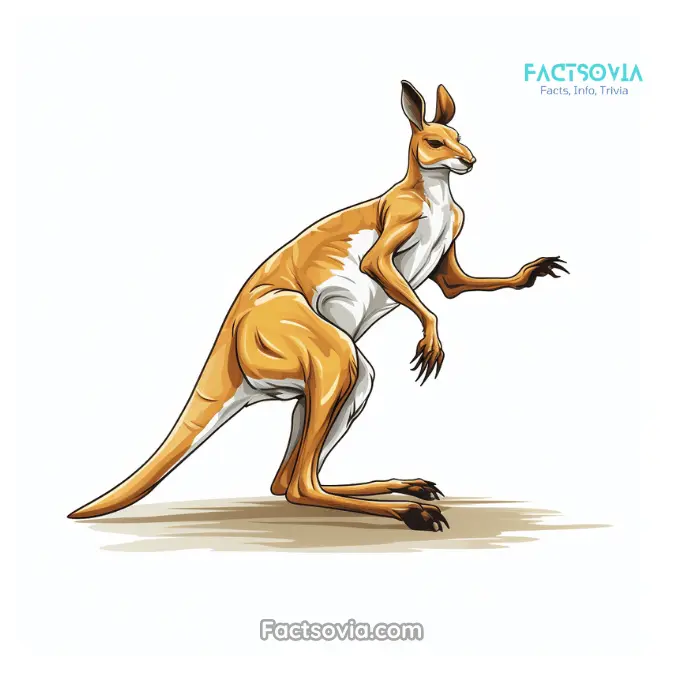We use affiliate links to run our site. When you buy through links on our site, we may earn an affiliate commission, without any added cost to you. Learn more
Kangaroos are among the most fascinating creatures in the animal kingdom, with many unique characteristics that set them apart from other animals.
But perhaps one of the most intriguing aspects of these marsupials is their legs. How many legs does a kangaroo actually have? It’s a question that has puzzled people for years and the answer might surprise you.
In this article, we will explore everything you need to know about kangaroo legs, from their unique anatomy to their incredible agility.
We will also address common misconceptions about kangaroo legs and uncover the truth about these amazing appendages. So, get ready to hop into the world of kangaroo legs and discover something new!
Key Takeaways:
- Kangaroo legs are a marvel of nature and have adapted to suit the kangaroo’s unique lifestyle.
- Despite the popular belief that kangaroos have two legs, they actually have four.
- Kangaroo legs serve a variety of purposes beyond providing support for the animal’s body, including hopping, balancing, and defending against predators.
- Kangaroo feet are equipped with specialized characteristics that make them perfectly suited for the animal’s lifestyle, such as their unique toes.
- The design of kangaroo legs has evolved to ensure the survival of these incredible creatures in their unique environments.
Funny Facts About The Kangaroos
The Unique Anatomy of Kangaroo Legs
When we think of kangaroos, we often envision their powerful hind legs that allow them to effortlessly hop across the Australian outback. But there’s more to kangaroo legs than meets the eye.
These unique appendages play a crucial role in the animal’s survival and have evolved to suit their specific needs.
Kangaroo legs are incredibly strong, allowing them to jump great distances and even reach speeds of up to 43 miles per hour. But what makes these legs so remarkable are the specialized features that aid in movement.
For example, kangaroo feet possess four toes, with the second and third toes fused together to form a strong, supportive structure for hopping.
Another interesting feature of kangaroo legs is the way they are designed to conserve energy. A kangaroo’s leg acts like a spring, storing energy as it lands and releasing it with each subsequent hop. This design allows kangaroos to cover great distances with minimal effort.
In addition to their impressive hopping abilities, kangaroo legs also serve other important purposes. They provide balance for the animal when grazing on two legs and can be used as a defensive mechanism when fighting off predators.
Overall, the unique anatomy of kangaroo legs is a testament to the incredible adaptations that occur in nature. From their powerful muscles to their specialized feet, kangaroo legs are an engineering marvel that has allowed these amazing creatures to thrive and survive in their environment.
How Many Legs Do Kangaroos Have?
It’s a question that has puzzled many people: how many legs does a kangaroo have? Some may assume that kangaroos have four legs, like most mammals. Others may be aware that kangaroos primarily use their powerful hind legs to hop, leading them to believe that kangaroos have only two legs.
So, what’s the real answer? According to the scientific consensus, kangaroos have two legs. Their hind legs are incredibly powerful and designed for hopping long distances, while their forelimbs are smaller and primarily used for balance and support.
Despite this, the misconception that kangaroos have four legs or even five legs persists. This may be due in part to the way kangaroos move – their tail acts as a third “leg” to help them balance while hopping. However, when it comes to the official count, kangaroos only have two legs.
Kangaroo Legs: More Than Just Support

While kangaroo legs are undoubtedly crucial for providing support to the animal’s body, they also serve a variety of other purposes. For example, kangaroo legs are integral to the animal’s hopping movement.
The hind legs of a kangaroo are exceedingly powerful and can propel the animal to great heights and distances. In fact, kangaroos have been known to cover up to 30 feet in a single hop!
Beyond hopping, kangaroo legs also play a role in balancing. When a kangaroo is standing upright, its tail acts as a third point of contact with the ground, allowing the animal to maintain balance without exerting too much energy.
This is especially important for female kangaroos, as they often need to balance themselves while carrying their young in their pouch.
Kangaroo legs are also valuable assets when it comes to defending against predators. If a kangaroo is threatened or attacked, it will use its hind legs to deliver powerful kicks to the attacker.
These kicks can be extremely dangerous and have been known to kill animals such as dogs and even humans in rare cases.
Another surprising fact about kangaroo legs is that they are equipped with specialized feet that aid in gripping and traction. The feet of a kangaroo are broad and have four toes, each with a strong claw that assists in grasping the ground when hopping or walking.
Overall, it is clear that kangaroo legs are more than just simple supports for the animal’s body. They serve a multitude of important functions and are a testament to the remarkable capabilities of nature’s design.
What is a Group of Kangaroos Called?
The Remarkable Agility of Kangaroo Legs
When it comes to mobility, kangaroo legs are some of the most impressive in the animal kingdom. With their powerful hind legs, kangaroos can cover great distances with ease and reach speeds of up to 56 km/h (35 mph).
But what sets kangaroo legs apart from other animals’ legs? For one, kangaroos have a unique joint in their hind legs that allows them to store and release energy with incredible efficiency.
This mechanism, known as the “spring in the step,” enables kangaroos to conserve energy while hopping and cover long distances without tiring.
Another key aspect of kangaroo legs is their versatility. While they are primarily used for hopping, kangaroos can also walk, crawl, and even swim using their legs.
The ability to switch between different modes of movement makes kangaroos highly adaptable to different environments and situations.
So, do kangaroos have two or four legs? The answer is that kangaroos technically have two legs, as their other “legs” are actually powerful forelimbs that are used for balance and support.
However, the hind legs are the true stars of the show when it comes to kangaroo mobility.
In addition to their impressive physical capabilities, kangaroo legs also play a role in social communication. When fighting or defending their territory, male kangaroos will use their legs to kick and box with one another, displaying their strength and dominance.
All in all, kangaroo legs are an amazing example of nature’s design for mobility and survival. From their efficient energy use to their adaptability and social communication, these legs truly have it all.
Kangaroo Legs vs. Arms: What’s the Difference?

Kangaroos are fascinating creatures with unique anatomy, including their legs and arms. While the hind legs are the most prominent feature, kangaroos also possess forelimbs, commonly referred to as arms or hands.
The main difference between kangaroo legs and arms is their function. The hind legs are incredibly powerful and serve as the primary means of locomotion, enabling the kangaroo to hop long distances with ease. The forelimbs, on the other hand, are much smaller and weaker in comparison.
Kangaroo arms are primarily used for balance and support while the animal is grazing or standing upright. They are also used for grooming and scratching, as well as for defense against predators. The hands of a kangaroo are equipped with sharp claws that can inflict serious harm to any potential threats.
Overall, while both the hind legs and forelimbs are essential for the kangaroo’s movement and survival, it is the hind legs that are the true marvel of nature’s design. However, the unique features of the forelimbs play an important role in the kangaroo’s lifestyle and should not be overlooked.
Debunking the Myth: Do Kangaroos Have 5 Legs?
There is a persistent myth that kangaroos have five legs, but this is not true. Kangaroos, like most other animals, have four legs. They have two hind legs and two forelimbs, or arms, which they use for various activities such as grasping food and balancing.
The misconception that kangaroos have five legs likely stems from their unique anatomy. Kangaroos have a long, muscular tail that they use for balance while hopping. When a kangaroo is standing upright on its hind legs, it may appear as if its tail is a fifth leg. However, the tail is not a leg and cannot support the weight of the kangaroo’s body.
So rest assured, when someone asks you if kangaroos have five legs, you can confidently tell them that they only have four – two powerful hind legs and two versatile forelimbs. And the next time you spot a kangaroo, take a moment to appreciate the incredible design of their legs and the unique adaptations that have made them one of the most iconic animals in the world.
Can Kangaroos Walk on Their Tail?
One of the most fascinating aspects of kangaroo legs is their ability to balance and move with incredible grace. While kangaroos are primarily known for their hopping, they also use their tail for balance and movement. This has led to the question – can kangaroos walk on their tail?
The truth is, that kangaroos cannot walk on their tail alone. However, they do use their tail as a “fifth leg” for support and balance while hopping. The tail acts as a counterbalance, helping the kangaroo to shift weight and change direction in mid-air.
Additionally, when a kangaroo is grazing or standing still, they use their tail as a tripod, propping themselves up and allowing them to conserve energy while they rest.
So while kangaroos cannot walk on their tail alone, it is a crucial part of their locomotion and survival.
The Intricacies of Kangaroo Feet
Kangaroos are unique animals with distinctive anatomy, and their feet are no exception. Their hind feet are long and adapted for hopping, while their front feet are smaller and used for grasping food and balance.
One of the most striking features of kangaroo feet is the large fourth toe, which is elongated and curved to provide propulsion during hopping. The fifth toe is vestigial, meaning it is present but no longer functional. This toe is used for grooming and is not in contact with the ground during locomotion.
The hind feet also have powerful tendons and muscles that store and release energy during hopping, allowing kangaroos to travel long distances with ease. In addition, kangaroo feet possess thick and spongy pads on the soles to absorb shock upon landing.
As for the front feet, they have five toes with sharp claws to assist with climbing and defense against predators. The front feet are also used to grip and pull vegetation towards the kangaroo’s mouth for feeding.
In conclusion, kangaroo feet are a remarkable example of nature’s design, perfectly adapted to the animal’s unique lifestyle and movement. With their elongated fourth toe, powerful tendons and muscles, and thick pads, kangaroos are able to hop vast distances with incredible agility and efficiency.
Kangaroo Legs: Nature’s Design for Survival
Kangaroo legs are a marvel of nature’s craftsmanship. These two powerful hind legs enable the kangaroo to cover great distances with ease and reach speeds of up to 56 km/h (35 mph).
But kangaroo legs are more than just a means of locomotion. They are perfectly adapted to the kangaroo’s unique lifestyle and environment, providing the animal with a range of capabilities that are essential for survival.
In fact, the structure of kangaroo legs is so efficient that scientists have studied them for inspiration in designing prosthetic limbs for humans.
But how do kangaroo legs compare to those of animals with more than four legs?
Despite the popular misconception that kangaroos have five legs, they actually only have two. But these two legs are more than enough to provide the animal with the agility and power it needs to thrive in its natural habitat.
So next time you see a kangaroo bounding across the Australian outback, take a moment to appreciate the incredible design of its legs – a true testament to the ingenuity of nature.
7 Key Differences Between A Wallaby and A Kangaroo
Can Kangaroos Stand on Their Tail?
One of the most fascinating aspects of kangaroo anatomy is their unique tail. It serves various functions such as aiding in balance, communication, and even as a fifth limb. However, can kangaroos stand on their tail?
While kangaroos cannot stand upright on their tail alone, they can balance on it for short periods. The tail acts as a counterbalance, helping the kangaroo maintain stability while standing or hopping. This is particularly useful for male kangaroos, who use their tail to support their weight while boxing with other males.
Additionally, the tail can be used as leverage to pivot and change direction quickly, giving the kangaroo an advantage when evading predators.
So, while kangaroos cannot stand on their tail like a tripod, they have certainly adapted it for various purposes in their daily lives.
Conclusion
After delving into the fascinating world of kangaroo anatomy and exploring the unique structure of their legs and feet, we can confidently answer the question – how many legs does a kangaroo have? The answer is four!
But kangaroo legs are so much more than just support for the animal’s body. They have evolved to suit the kangaroo’s unique lifestyle, allowing them to move with impressive agility and balance. From hopping long distances to defending against predators, kangaroo legs are a marvel of nature.
We’ve also debunked some common myths surrounding kangaroo legs, such as the idea that they have five legs. While they may be able to balance on their tail, kangaroos do not actually stand or walk on it.
All in all, kangaroo legs are a testament to nature’s ingenuity and design for survival. So the next time someone asks you how many legs a kangaroo has, you can confidently tell them the truth – and share some of the amazing facts you’ve learned about these incredible creatures.
FAQs
How fast can kangaroos hop?
Kangaroos can hop at speeds of up to 40 miles per hour, making them one of the fastest-hopping animals.
Do kangaroos have arms or just legs?
Kangaroos have both legs and forelimbs. Their hind legs are highly developed for hopping, while their forelimbs are smaller and used for tasks such as grooming and grasping.
How many legs does a kangaroo have?
Kangaroos have two legs. They are bipedal animals, meaning they walk on two legs.
Amazon and the Amazon logo are trademarks of Amazon.com, Inc, or its affiliates.
